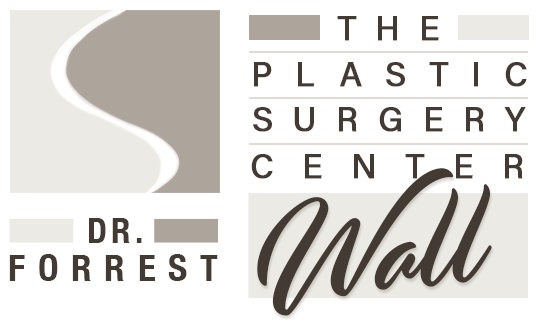When women inquire about Shreveport breast augmentations, one of the most common questions they have is regarding where the implants should go. Should they get over or under the muscle breast implants? Some women may already have a predisposed opinion on what they feel is the “right” answer. However, it is important to enter the process with an open mind. You might be surprised which placement works best for you and your specific body type.
At The Plastic Surgery Center, our board-certified plastic surgeon, Dr. Forrest Wall, will take the time to explain each possibility to you. During your consultation, Dr. Wall will examine you and discuss your goals and expectations. From there, the two of you can decide together what option is most suitable for you. In this post, we’ll discuss some of the basics of each placement, including the pros and cons of each.
Breast Implants Under the Muscle vs Over
There are several things that you must take into consideration when setting your goals for breast augmentation. Of course, you must first determine how big you would like your implants to be. You may decide you want to simply go from an A cup to B cup, or maybe you’re even considering D cup implants. This is certainly an important decision, but it is not the only one you must make regarding your implants.
Another decision you have to make is what type of implant you’re looking for. There are pros and cons to both gummy bear and silicone implants, and your doctor will go over these with you during your consultation. There is also the choice of round or teardrop-shaped implants. Your body type can certainly influence these deciding factors, but the choice is ultimately up to you.
Yet another very important decision you must make is the placement: over or under the muscle breast implants. Subglandular placement refers to placing the implants over the pectoralis major muscle and beneath the glandular breast tissue. The other option is placing the implants under the pectoral muscle, also known as submuscular placement.
Over the Muscle Breast Implants
For over-the-muscle breast implants or sub-glandular implants, the implant goes below the breast tissue and above the pectoral muscle. Women who have a decent amount of breast tissue already may achieve the best results with implants that are placed over the muscle. The more tissue you have, the better. This is because breast tissue provides a foundation that won’t allow your new look to appear too artificial.
Placing implants above the chest muscle can make for an easier procedure with a shorter recovery time. Women who have this procedure done tend to suffer from less post-op pain in comparison to those who have the implants placed beneath the pectoralis major muscle.
However, for women with a lesser amount of natural breast tissue, sub-glandular placement poses the risk of rippling the implants. Visible folds of wrinkles may appear if there is not a solid amount of natural fat covering the implant.
Under the Muscle Breast Implants
Under-the-muscle implants, technically known as submuscular implants, entail the implant being placed below the pectoral muscle. This procedure tends to be more common because it is best for women who have little natural breast tissue. Since a majority of breast augmentation patients who seek implants do so because they don’t possess this tissue naturally, this is often the recommended route.
Placing implants beneath the chest muscle offers additional coverage and support that won’t distort the breast or cause an unnatural look. However, a submuscular implant procedure requires a bit more work on the surgeon’s part than a sub-glandular implant procedure. This is because, as you may have already put together, they must go further into the breast and operate beneath the muscle. In a sub-glandular procedure, your pectoral muscle will not be as disturbed as it would be in a submuscular procedure. This results in a more lengthy and painful recovery time.
When making a determination for what placement is right for you, it’s important to consider where the natural breast tissue falls in relation to the pectoral muscle. The pectoral muscle sits high on the chest wall, spanning from the sternum to the shoulder. If your breasts fall much lower than the muscle, whether from aging, breastfeeding, or the like, under the muscle implants may not be advisable. This is because it can cause the implants to appear unnaturally high on the chest, making them appear unnatural and even distorted.
Over the Muscle Implant Pros and Cons
There are several pros and cons for both sub-glandular and submuscular breast implants. Below, we’ll provide a list of some of the pros that go along with sub-glandular, or over-the-muscle implants.
Pros of Sub-Glandular Breast Implants
- Produces a “lifted” appearance of the breasts for patients whose breasts tend to sag.
- As the body ages and the breasts fall downward, this implant will move with them.
- Allows the breasts to appear real and natural for years to come.
- Eliminates risk for dynamic distortion.
- Implants won’t flatten or move around the chest wall when flexing muscles.
- Quicker and less painful recovery time.
As there are some great pros to sub-glandular breast implants, there are also, unfortunately, some cons. We’ll provide them below.
Problems With Breast Implants Over the Muscle
- Higher risk of capsular contracture.
- Capsular contracture occurs when the breast tissue around the implant hardens.
- Can cause pain and appear unnatural.
- Can increase the risk of rippling in patients with less breast tissue.
- Breast tissue may be harder to see on mammograms, which can impact the rate at which doctors can spot and diagnose cancerous tissue.
Pros and Cons of Under the Muscle Implants
Benefits of Under the Muscle Implants
- Reduces the risk of capsular contracture.
- Capsular contracture occurs when the breast tissue around the implant hardens.
- Can cause pain and appear unnatural.
- Creates a more natural breast contour for patients with very little breast tissue or fat.
- Reduces the risk of rippling.
- Rippling is more likely to occur for those receiving sub-glandular placement and who have smaller breasts and thin bodies.
- Allows breast tissue to be much more visible on a mammogram.
- It is medically safe for implants to go both above and below the chest muscle. However, in those with an increased risk of breast cancer, you may want to consider what is best for your future health.
Some of the risks and concerns associated with under-the-muscle breast implants include the following:
Problems With Breast Implants Under the Muscle
- An increased risk for dynamic distortion.
- Implants may become flattened or distorted when the muscles of the chest flex.
- Submuscular breast implants are not recommended for those who have a seriously fitness-oriented lifestyle or lift weights regularly.
- Implants can become displaced.
- The constant force on the implant from the muscle can potentially dislodge the implant.
- Especially true for smooth-walled, submuscular implants.
- Longer and more painful recovery time.
- More disruption within the breast results in increased discomfort during recovery.
Breast Implants Over The Muscle vs Breast Implants Under the Muscle Recovery
Of the two placement options, submuscular implants are generally the more invasive of the two. This is because it requires the surgeon to separate the pectoral muscle to make room for the implant. The amount of disruption that occurs in the chest wall during surgery plays a direct role in how long and painful the recovery will be.
A sub-glandular placement may be less painful and have much less downtime post-operation. It may keep the patient away from work or any other physical activity for 2-3 days. For a submuscular placement, it may be about a week before they can return to work and/or other physical activities.
However, for both procedures, the approximate recovery time is also dependent on the location of the incisions as well as the size of the implants. Larger implants require larger incisions, which will, in turn, take longer to heal. It may take anywhere from 2 to 4 weeks to completely heal from a breast augmentation, despite whether it’s over or under the muscle breast implants. The estimated recovery time for these procedures is unique to each patient and their individualized treatment plan.
Breast Implant Surgeon in Shreveport, LA
Here at The Plastic Surgery Center, we’ve been producing beautiful, long-lasting results for patients in the Ark-La-Tex area for a number of years. Our Shreveport board-certified plastic surgeon, Dr. Forrest Wall, makes sure that each patient achieves the most desirable results.
If you have any more questions regarding over or under-the-muscle breast implants, contact our offices today! You can call us in Shreveport at 318-221-1629 or our Monroe center at 318-812-0182.

